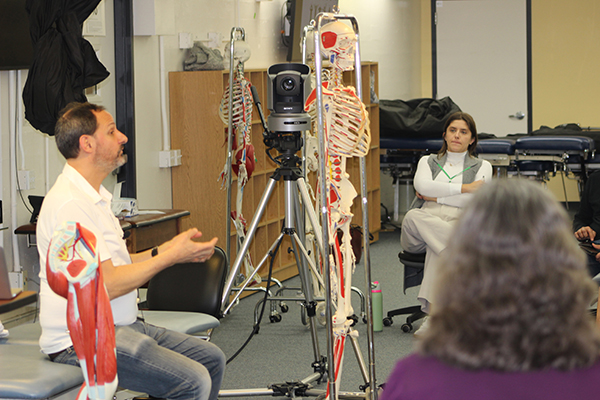Bright Future Ahead for Touro DOs
Symposium on Mare Island Campus Draws Alums to Teach, Further Profession of Osteopathic Medicine

The future of Osteopathic Medicine is bright, a presenter at the 6th Annual Integrative Medicine Symposium says.
Dr. Daniel Shadoan (DO 2002) has been in private practice since 2005 and specializes in Osteopathic Manipulative Medicine He sees a bright future for the profession of Osteopathic Medicine in the U.S. and takes part in efforts to forward the profession in general and his specialty in particular.
Returning to the campus on Mare Island and presenting at the Symposium is among those efforts.
“I’m very committed to the profession of Osteopathic Medicine, and committed to the Osteopathic Manipulative Medicine specialty,” Shadoan says.
There are just a few schools that focus on OMM techniques, “so I’m very committed to passing that on,” he says. “I feel if more people knew about Osteopathic Manipulative Medicine, they would take more advantage of what Touro has to offer,” he says of prospective doctors.
Growing Demand for DOs in Primary Care
Shadoan has high praise for the role Touro University California plays in forwarding the profession, as well as its role in the future.
“As a profession, there’s a huge demand for primary care in rural areas. And DO schools send lots of primary care doctors to rural areas,” Shadoan says. “So I feel like there’s a lot of room to grow in Osteopathic Medicine, and it is growing.”
Shadoan notes that 1 in 4 medical students are in an Osteopathic Medicine school. The profession is experiencing enhanced name recognition and a better understanding of its tenets among the public, he says, particularly in the area of primary care.
The education of those studying Osteopathic Medicine “is equal to or better than MDs,” Shadoan says.
Doctors of Osteopathic Medicine are trained with primary care as the default rather than a medical specialty as is common among medical doctors, he says. They learn what MDs learn in medical school, with Osteopathic Medicine added into the equation.
But there are challenges ahead that come with the profession’s rapid growth. Among them is a need to produce enough DOs not only to teach Osteopathic Medicine at the university level, but also to serve as preceptors for the growing number DOs across the country.
“Can the profession provide enough people to teach?” he asks. “Can the profession procure enough DOs to meet the demand?”
Shadoan offers the wisdom of experience to prospective as well as new DOs.
First is this: “It’s a marathon, not a sprint,” he says. “The key thing is to preserve your energy and sanity for the long haul.”
Next: “Don’t assume you’ll never need something that you’re learning because you never know when you’ll need that knowledge,” he says.
Extensive Background Enhances Practice
Shadoan’s practice combines traditional Osteopathy, including cranial approaches, with homeopathy, and natural and conventional medications as indicated. Shadoan is Board Certified in Neuro-Musculoskeletal Medicine/Osteopathic Manipulative Medicine and has completed the Osteopathic Cranial Academy Proficiency requirements. He is a part of the regular teaching faculty, a Past President, and a Fellow of the Osteopathic Cranial Academy.
Born in San Francisco, Shadoan received his bachelor’s degree in history from Columbia University. After graduating from the Touro University California College of Osteopathic Medicine, he took part in a traditional rotating Internship and Residency in NMM/OMM at St. Barnabas Hospital in the Bronx, New York. Shadoan completed homeopathic training with the Center for Education and Development of Clinical Homeopathy in 2010.
In addition to teaching with Dr. Eliott Blackman and the OCA, he has taught Osteopathy with Dr. Viola Frymann, DO, the American Academy of Osteopathy, and at Touro University California, where he is an Adjunct Clinical Professor in the Department of OMM. Shadoan has given frequent lectures on Osteopathy including at UC Berkeley, UCSF, San Francisco State University, the Child Development Center at Sutter Health California Pacific Medical Center, and the Nevada Academy of Family Physicians.
Shadoan’s presentation was titled “Levers, Arches, and Inherent Motions.”
Details of the Symposium
Touro University California alumni figured prominently in the Symposium that occurred Jan. 21 on campus.
Members of the campus Integrative Medicine Club organized the Symposium with support from Dr. Victor Nuño, (DO 2008), a Professor in the College of Osteopathic Medicine.
The symposium featured five tracks, each designed to contribute to the health and wholeness of attendees and their patients. Of note was the substantial Osteopathic Manipulative Medicine track with five speakers, demonstrating a commitment to hands-on treatment modalities.
This year’s Symposium adopted a hybrid approach, blending in-person and virtual elements. It was the first in-person Symposium since the start of the COVID-19 pandemic.
Student-Doctor Jia-Min Ooi, a member of the club that organizes the Symposium, says they tried to balance the importance of in-person interactions with the benefits of virtual access to national experts. Nuño also notes how the pandemic forced the Symposium online. The experience gained through the online symposiums allowed for this year’s hybrid version – offering the best of both experiences.
The transition to virtual events as a result of the pandemic brought both advantages and challenges, Nuño says: It allowed for a broader reach and inclusion of speakers from around the world, while it also posed difficulties for hands-on treatments like OMM.
Four other Touro University California graduates also presented during the symposium:
- Nuño gave a presentation titled “Refining Your HVLA.”
- Dr. Stacia Sloane (DO 2014) gave a presentation titled “Experiential Anatomy.”
- Dr. Tinh Vuong (DO 2006) gave a presentation titled ”Introduction to Energy Medicine and Therapeutic Technologies: Extracorporeal Magnetotransduction Therapy and Extracorporeal Shockwave Therapy.”
- Dr. Sara Modlin-Tucker (DO 2017) gave a presentation titled “Shifting Pain with Your Brain: Using a Biopsychosocial Model for Pain Reduction.”
